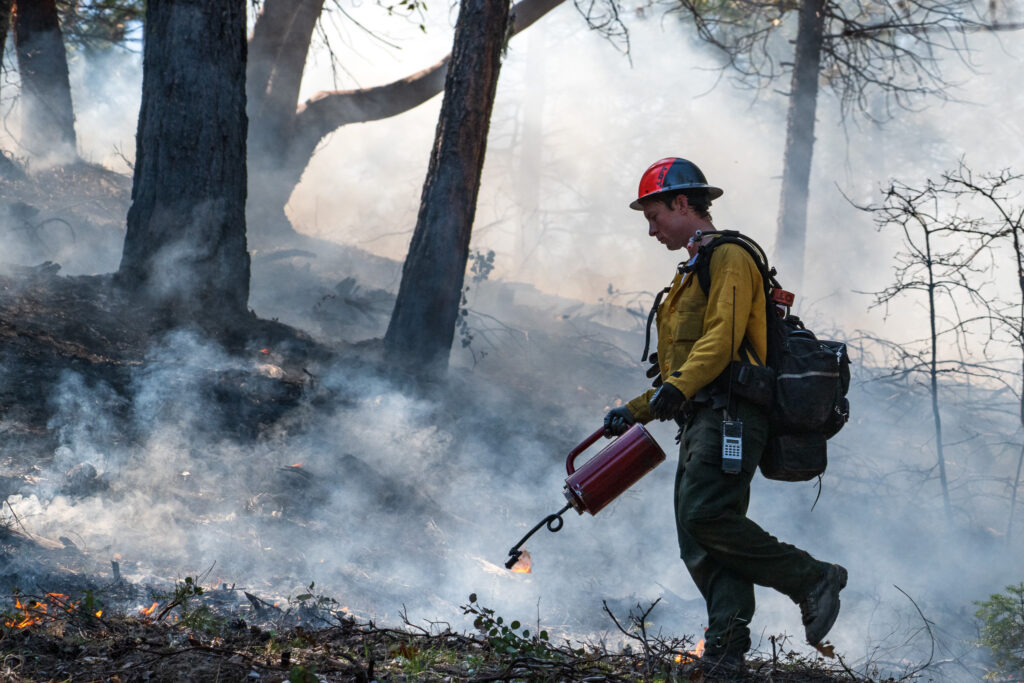Firefighters undertake a prescribed burn at the Upper Applegate Watershed near Medford on Thursday, April 27, 2023. Such burns can help reduce the risk of large wildfires. (Kyle Sullivan, Bureau of Land Management/Flickr)
Oregon and Washington leaders are using the start of the region’s wildfire season to once again ask Congress for more money for prescribed burns.
The practice of strategically starting low-intensity fires across forests to improve soil and ecosystem health and prevent catastrophic wildfires has been common among tribes in the West for millenia. In recent years, it has gained more traction among the U.S. Forest Service, the Bureau of Land Management and the Oregon Department of Forestry as an urgently needed wildfire prevention tool. But increasing the scale and speed of such burns has been difficult due to fears of unhealthy, smoky air and the potential for fire to jump to private property.
To address these issues, U.S. Sen. Ron Wyden, D-Oregon, and U.S. Rep. Kim Schrier, D-Washington, recently introduced the National Prescribed Fire Act of 2024, a third attempt to direct hundreds of millions of federal dollars for prescribed burning to the Forest Service and the U.S. Department of the Interior. The legislators previously tried to pass the act in 2020 and 2021, but it died in the Senate Committee on Energy and Natural Resources both years. Instead, the 2021 Bipartisan Infrastructure Law earmarked $500 million in funding for the Interior Department and Forest Service to plan and conduct prescribed fires.
The latest iteration of the prescribed fire act, if passed, would increase the pace and scale of prescribed burning in the region, including a $300 million annual allocation to the Forest Service and the Department of the Interior to plan and execute burns on federal, state and private lands. Prescribed burns on federal land now require up to eight years of planning and preparation. The act also would also invest in training a skilled workforce to take on the prescribed burning.
“Prescribed fires are the underfunded, often overlooked, and less expensive fire extinguishers backed by science, which every state needs in their back pocket,” Wyden said in a news release.
The act would require state agencies to allow larger prescribed burns by aligning state air quality guidelines with federal guidelines. In the Northwest, air quality guidelines tend to be more stringent when it comes to smoke, according to Forest Service research. The prescribed fire act would require more flexibility for winter burning and would provide clear standards to protect practitioners of prescribed burns from legal liability.
More than a dozen conservation, forestry and fire fighting groups, including The Nature Conservancy, the Portland-based nonprofit Sustainable Northwest and the Society of American Foresters, also back the legislation, as do the Confederated Salish and Kootenai Tribes.
Dylan Kruse, vice president of Sustainable Northwest said in a news release that Congress should pass the prescribed fire act “immediately.”
“Prescribed and cultural burning are the most effective, yet underutilized tools to address the nation’s wildfire crisis,” he said.
Oregon Capital Chronicle is part of States Newsroom, a nonprofit news network supported by grants and a coalition of donors as a 501c(3) public charity. Oregon Capital Chronicle maintains editorial independence. Contact Editor Lynne Terry for questions: info@oregoncapitalchronicle.com. Follow Oregon Capital Chronicle on Facebook and Twitter.
The post Northwest leaders try again for more federal money for prescribed burns to prevent wildfire appeared first on Washington State Standard.

